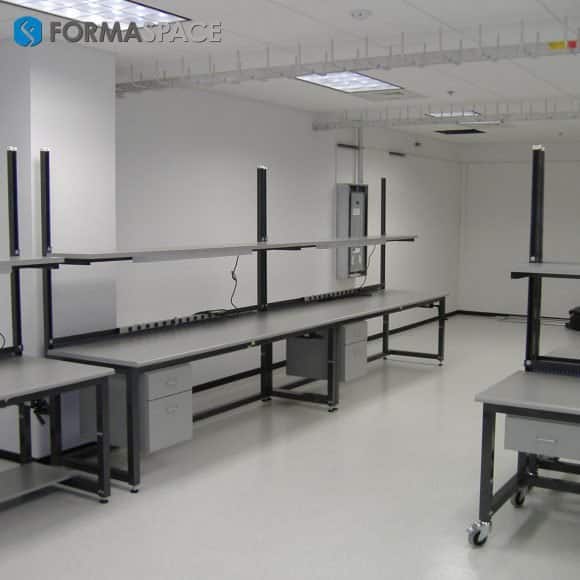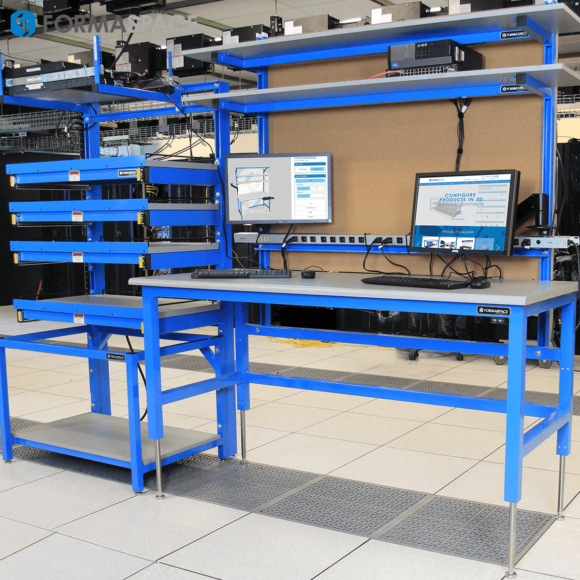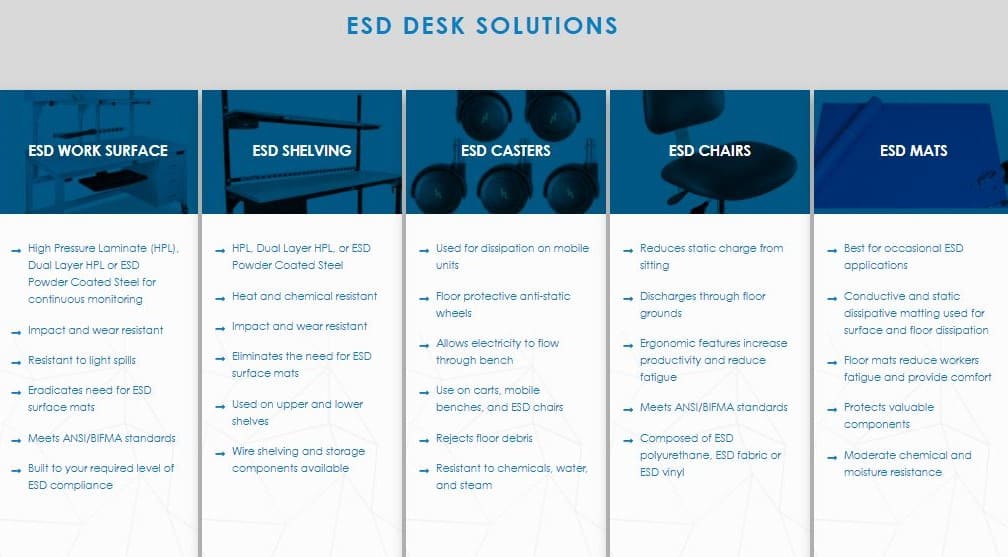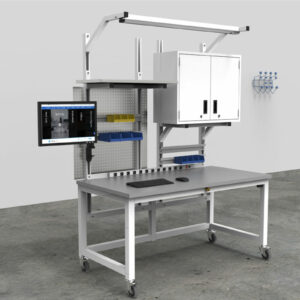As a society, our lives are increasingly dependent on powerful yet microscopic electronic circuits that power the smartphones, computers, automobiles, appliances, or aircraft that we depend on every day.
Progress in miniaturization is at the heart of increasing the performance of integrated circuits, with the latest designs built around transistors that are so small that they are approaching the size of individual atoms.
Yet, as electronics become smaller, the risk of accidental damage from electrostatic discharge (ESD) increases, and, given the ubiquity of electronic components in nearly every consumer and industrial design in use today, the problem of how to prevent ESD damage has grown beyond the bounds of computer chip manufacturers to the industry at large – which must grapple with how to handle, test, assemble, diagnose, repair, or pack and ship electronic circuit boards without damaging them internally.
We take a look at twelve steps you can take to organize an ESD protection program at your facility.
1. Understanding the Need for ESD Standards Compliance
The first question to address is why you should invest in an ESD-proof protection program at all.
Electrostatic discharge (ESD) is like a hidden tax on the electronics manufacturing industry, with some analysts calculating that ESD losses reduce industry revenues by 6.5% on average.
In an ideal world, any ESD damage to microelectronics could be identified at the factory through quality assurance testing; however, ESD damage is a pernicious foe – oftentimes, ESD-damaged electronics fail later, often during the burn-in phase, e.g. once they are in consumers’ hands or embedded in mission-critical industrial products.
The consequences of ESD-caused electronics failure can vary depending on the industry sector – for consumer-electronics companies, it can drive up the warranty costs while it drives down a company’s brand reputation. For mission-critical components in industries such as aerospace or healthcare, ESD-caused failures can literally become a matter of life or death.

The logical place to start any new ESD protection program is to study the relevant ANSI/ESD S20.20-2016 standard for the protection of electrical and electronic parts, assemblies, and equipment. This document can be purchased on the ANSI web store, and it’s a highly recommended investment for creating your own ESD Control Program.
2. Perform a Needs Assessment / Risk Measurement
The next step is to perform a needs assessment to establish your particular ESD protection requirements, including quantifying the potential risks.
For example, at an electronics manufacturing facility, it’s quite likely that there is already a very well-established ESD protection program in place (the need for this has become well understood over the last 20 years).
But that’s not generally the case at other types of manufacturing companies, many of which are new to the idea of incorporating electronic components into their production lines.
(In other words, the chances are good that ESD has become an issue for your manufacturing facility – given that nearly every product made today includes some form of microprocessor component.)
Bear in mind that the manufacturing assembly line is not the only place to perform an ESD risk assessment.
You might find that quality assurance, maintenance, and repair, and material handling operations (including packing stations) are functions that need to be assessed as well, as they may need to up their game when handling sensitive electronic components by protecting them with a comprehensive ESD protection program.

Once we’ve assessed which processes or departments we need to protect, it’s time to look at measuring the potential risk; in other words, what’s the scope of possible damage that can occur, as measured in terms of voltage that can be accidentally transmitted to vulnerable electronic components.
The ANSI/ESD S20.20-2016 standard mentioned in the previous section is designed to do just that. It outlines the potential risks and mitigation measures you can take.
But putting this technical document into good use requires a little bit of explanation for the layperson who lacks the electrical engineering background needed to read and understand it properly.
For example, the standards written into ANSI/ESD S20.20-2016 are meant to “protect electrical or electronic parts, assemblies, and equipment susceptible to damage by electrostatic discharges greater than or equal to 100 volts HBM, 200 volts CDM, and 35 volts on isolated conductors.”
But what does that mean in plain English?
Let’s break this down step-by-step.
The first term is HBM, which stands for the human-body model; as the name implies this is a scientific model of how much voltage (e.g. electrostatic discharge) can be transferred from the human worker to an electronic device, such as an integrated circuit (IC).
Human bodies (or other conductive objects) can get electrostatically charged if not grounded. (Think about walking across the carpet during wintertime when the humidity is low and touching something metal – the big static shock that you feel through your fingertips is quantified by the human body model.)
The HMB is covered in more detail in ANSI/ESD STM5.5.1-2016, which identifies 7 specific class levels of protection.
The charged-device model (CDM) is an alternative scientific model that can be used instead of the human body model in some instances; see ANSI/ESD SP5.3.3-2018. It simulates the effect of static charge being conducted through one pin or connector.
And finally, an isolated conductor in this context refers to an isolated metal object (e.g. something that’s not in contact with another conductor) that might have a charge on the outer surface. (A good example is an isolated metal desk with rubber wheel casters that prevent it from being grounded to a metal floor.) It’s important to remember that the charge on an isolated conductor is spread out over the entire surface; meaning it might have a very low voltage overall but can still cause major ESD damage.
3. Choose Ruggedized Electronic Components
At this point, you might be thinking to yourself that establishing an ESD protection program sounds complicated and expensive – “wouldn’t it be cheaper and simpler in the long run just to specify integrated circuits and electronic components that are somehow ‘hardened’ against damage from electrostatic shocks?”
This is a really good point.
Indeed, many manufacturers in the electronics industry have invested heavily in attempting to do just that, e.g. ruggedize their electronic components so that they are more resistant to potential damage from wayward electrostatic shocks.
Choosing to specify electronic components with greater internal protection against ESD can make economic sense (assuming the products are available and offered at a reasonable price).
However, this is not an overall panacea, given that most electronic assemblies are made from a collection of parts sourced from a variety of different manufacturers, and their ability to resist ESD damage will only be as strong as the weakest link in the chain.
4. Create an Electrostatic Discharge (ESD) Protection Plan
If you’ve been in the manufacturing world for any length of time, you’re probably very familiar with the earthy expression: Prior Planning Prevents P*** Poor Performance.
Even though the expression may not be the best one for use in polite conversation, it’s a useful reminder that if we don’t make a workable plan, we can’t expect to achieve measurable results and improvements.
This is especially true for managing ESD, given that it’s an invisible threat, one that requires rigorous adherence to standard operating procedures in order to achieve successful results.
So how do you go about creating an electrostatic discharge (ESD) Protection Plan?
Theoretically, you could derive a plan by studying the ANSI/ESD S20.20-2016 standard; however, while that document is important to read from cover to cover, it’s also useful to look over the implementation plans from other organizations.
One problem is that most of these will tend to be proprietary and confidential; however, one organization with an exceptionally well-documented ESD plan is NASA, and, as a publicly funded government entity, its plans are not proprietary and thus available for download: See NASA document NASA-HDBK-8739.21: Workmanship Manual for Electrostatic Discharge Control (Excluding Electrically Initiated Explosive Devices)
(Disclaimer: NASA is a Formaspace customer)
We also think you’ll find it useful to download a NASA PowerPoint overview that explains how to implement an electrostatic discharge protection plan based on the earlier ANSI/ESD S20.20-2014 standard in accordance with NASA’s own NASA-HDBK-8739.21 document.

5. Designate an ESD Control Program Manager (and ESD Program Monitor)
If you’re familiar with management tools such as Six Sigma, you’ll know that if you want to get something done right within an organization, you need to identify a point person to be in charge of establishing and championing a plan, overseeing its implementation, as well as administering the program and measuring its ongoing results in order to achieve your goals.
In the case of electrostatic discharge, the ANSI/ESD S20.20-2016 standard calls out the need for identifying an ESD Control Program Manager to oversee the development of a program, including an implementation plan, establishing configuration control procedures (including records keeping), employee training programs, quality audit teams (including audit coordinators), as well as writing local ESD control plans for each individual workstation or job function that interfaces with vulnerable electronic components.
To be successful, an ESD Control Program Manager will need the assistance of one or more designated ESD Program Monitors (depending on the size of the organization or the number of functions involved) to help administer the ongoing administration, training, and auditing.
It will also be necessary to address your supplier community as well by establishing an ESD point of contact (POC) for each of your components suppliers.
6. Determine the Scope of Safe Work Practices across the Organization
Once you have the right people in place, it’s time to get to work on identifying the scope of ESD safe work practices that apply to your organization.
Take a deep dive into the ANSI/ESD TR20.20-2016 document and identify all the potential requirements that you need to comply with for “manufacturing, processing, assembling, installing, packaging, labeling, servicing, testing comments acting, or otherwise handling electrical or electronic parts, assemblies, and equipment.”
Don’t overlook product packaging; if you’re involved at all with packing and shipping operations, it’s critical that you know how to safely pack sensitive electronic devices without causing unwanted electrostatic damage. Refer to the ANSI/ESD S541-2019 Packaging Material document for detailed information on what you need to know to accomplish this successfully.
7. Establish an ESD-Safe Working Zone, formally known as the Electrostatic Protection Area (EPA)
Once you’ve identified the scope of all the job functions and material handling operations that interface with sensitive microelectronics devices, it’s time to think about creating ESD-safe working zones.

But first, we need to learn another acronym: in the world of electrostatic discharge protection, we refer to an ESD safe working zone as the “EPA,” which in this case stands for the Electrostatic Protection Area (and not the Environmental Protection Agency.)
Broadly speaking, there are two guiding principles for creating an Electrostatic Protection Area or EPA.
The first guiding principle for preventing accidental electrostatic discharge is to make sure that every item in the workplace is grounded.
As we’ll learn in the following sections about furniture selection, garment protection, and floor design, grounding is a fundamental principle that needs to be taken seriously; it’s critical to maintain a constant electrical grounding connection between the earth, the building, the floors, the furniture, hand tools and equipment, the human body etc. in order to reduce the chance of accidental static discharge.
To learn more about this, read the ANSI/ESD S6.1-2019 standard for Grounding.
The second guiding principle is to reduce the buildup of static charge in the first place by selecting suitable materials, such as special fabrics for employee garments, special surface treatments, and materials for work surfaces, as well as using grounded metal floors instead of static electricity inducing carpets (FYI these items will be discussed in more detail in the sections below.) It’s also possible to use air ionizing systems to reduce ambient static charge buildup; see the document ANSI/ESD SP3.3-2016 for more information on this approach.
TIP: At NASA, items such as hand tools, garments, and equipment are marked with symbols that quickly indicate ESD protection information, such as whether a particular smock garment or storage bag is suitable for use in a particular ESD work environment. Other commonly understood symbols used at NASA include markings for Common Ground Point (CGP) locations where equipment can be connected to an acceptable electric ground.
8. Furniture, Seating, and Tool Selection
For each of the Electrostatic Protection Areas (EPA) we need to make some informed choices about what kinds of furniture, seating and tools to specify in order to ensure that we maintain proper grounding as well as minimizing the generation of static electricity.
Let’s talk about furniture first.
Here at Formaspace, we manufacture standard, semi-custom, and fully custom (bespoke) industrial furniture used in all manufacturing, assembly, material handling, packing operations, warehousing and distribution centers, maintenance facilities, quality assurance testing labs, and more.

Our approach is to build ESD protection into our furniture work surfaces rather than rely on limited performance ESD mats. Built-in ESD protection is available in several forms, including high-pressure laminate (HPL) work surfaces with a built-in antistatic layer or specially formulated antistatic powder coating materials that help protect our heavy-duty steel workbenches, desks, tables from electrostatic discharge.
In addition, Formaspace furniture products with built-in ESD protection include grounding strap attachments for workers to plug in their wrist attachments to ensure proper electrical grounding. Our furniture designs also include facilities for grounding to a common earth grounding point, such as through the neutral three-pronged electrical outlet or a special grounding rod connected to the earth. Talk to your Formaspace Design Consultant for more specific information. You can also refer to the ANSI/ESD STM4.1-2017 document on worksurface resistance measurements for more information and best practices.
Seating is another important consideration; many chairs can build up static electricity as well as the movement of garments against upholstery. The ANSI/ESD STM12.1-2019 standard on Seating provides important information on how to address these issues effectively.
Tools and equipment are an important consideration as well, as these could be sources of static charge and thus need to be grounded at all times. (Where possible, plastic tools that are designed to prevent static charge buildup should be used instead of tools made of conductive materials, especially ferrous metals.)
Of special concern are tools and equipment used in soldering processes because of the close proximity (e.g. touching) required for these operations; see the ESD STM13.1-2000 document for standards and best practices relating to Electrical Soldering/De-Soldering of ESD Protective Equipment and Materials.
9. Garment Protection
If you’ve ever taken clothes out of a hot dryer, you know how easy it is to get a shock at your fingertips due to the static electric charge created by fabrics rubbing together.
To learn more about the standards and best practices for choosing worker garments and under which circumstances, if necessary, to issue custom clothing, refer to the document ANSI/ESD STM2.1-2018 Protection of ESD Sensitive Items – Garments to learn about proper fabric selection as well as grounding strategies to prevent accidental static charge.
10. Floor Design
Shuffling your feet on a carpeted floor prior to touching a metal object, such as an elevator control panel, is a good way to learn about static electricity.
And that’s the guiding reason that Electrostatic Protection Areas (EPA) generally favor the use of grounded metal floor panels instead of fiber-based floor coverings, such as carpets.
More information about choosing suitable flooring materials and best practices for eliminating static discharge can be found in ANSI/ESD STM7.1-2020 Resistive Characterization of Materials – Floor Materials.
11. Employee Training Program
For many workers, transitioning to an ESD safe work environment is not very intuitive.
It can be hard to remember all the necessary and detailed standard operating procedures required to minimize the risk of damaging delicate microelectronic parts — particularly since it’s normally impossible to see the effects of electrostatic discharge (unless of course it’s an especially high voltage event which might cause a flash, sound or the burning smell from damaged equipment).
That’s why establishing an ongoing training program for employees is a critical part of an electrostatic discharge (ESD) protection plan.
Workers will need to learn specific handling operations, such as making sure that they are properly grounded, wearing the right protective gear and garments, as well as how to safely handle sensitive electronic components during operations such as assembling components, conducting quality tests with electronic equipment (such as voltmeter), or performing more invasive procedures such as soldering components together.
Training is also an ongoing effort, and even experienced workers will need to be recertified at regular intervals to refresh them on the latest techniques and procedures.
Records will also need to be maintained, documenting which employees have undertaken training programs.
12. ESD Safe Validation and Verification
Once your Electrostatic Discharge (ESD) Protection Plan is up and running, the final step is to ensure ongoing validation and verification.

In other words, can you ascertain whether the plan is meeting its current goals and what procedures have you put in place to validate the plan’s efficacy in the future?
For ideas on how to manage validation and verification of your ESD protective equipment and materials, you can refer to the ESD TR53-01-18 standard for guidance.
Formaspace is Your Partner for ESD Safe Furniture Solutions
If you can imagine it, we can build it, here at our factory headquarters in Austin, Texas.
Now is the time to contact your Formaspace Design Consultant to find out more about our custom furniture solutions with built-in ESD protection.
They stand ready to help you find the best solution for your ESD protection program.
You can also learn more about our extensive list of customers, including Apple, Dell Computer, Google, Oculus, Toyota, and SpaceX.















